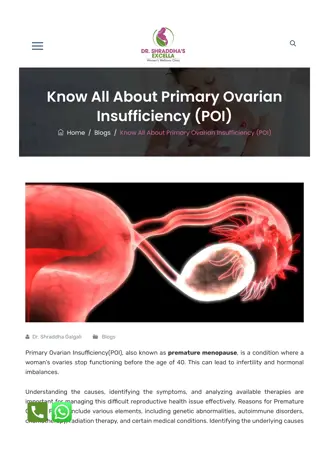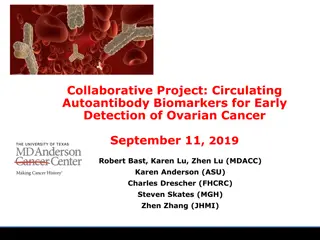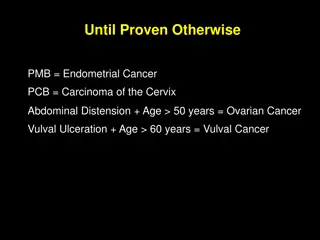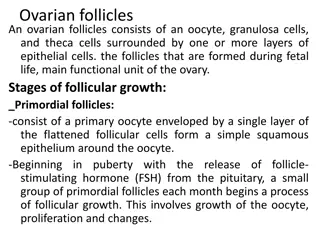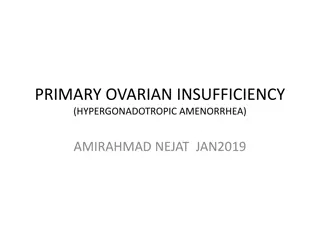OVARIAN CANCER
Dive into the world of ovarian cancer with a focus on Karima Salama, exploring the latest research, treatment options, and personal stories. Stay informed and educated on this important topic to empower yourself or support a loved one facing this disease. Discover valuable resources, tips on prevention, and join the fight against ovarian cancer today.
Download Presentation

Please find below an Image/Link to download the presentation.
The content on the website is provided AS IS for your information and personal use only. It may not be sold, licensed, or shared on other websites without obtaining consent from the author.If you encounter any issues during the download, it is possible that the publisher has removed the file from their server.
You are allowed to download the files provided on this website for personal or commercial use, subject to the condition that they are used lawfully. All files are the property of their respective owners.
The content on the website is provided AS IS for your information and personal use only. It may not be sold, licensed, or shared on other websites without obtaining consent from the author.
E N D
Presentation Transcript
OVARIAN CANCER KARIMA SALAMA
INTRODUCTION Second most common gynecologic malignancy. In developed countries, the incidence of 9.4 per 100,000 women and a mortality rate of 5.1 per 100,000. In developing countries, it is the third most common gynecologic malignancy (cervical cancer is the most common), with an incidence of 5.0 per 100,000 and a mortality rate of 3.1 per 100,000.
Coelomic epithelial origin (80 85%) Serrous 70% Mucinos 25% Endometrioid 20% Clear cell 5% Brenner tumor 2 3%... Mainly benign Undifferentiated. Carcinosarcoma
Germ cell origin ( 10 15 %) Teratoma Mature teratoma. Dermoid cyst. Stroma ovarii. Malignant neoplasm arising from teratomas. Immature teratoma. Dysgerminoma children and young adult, 10% bilateral. Endodermal sinus tumor. Emryonal carcinoma. Choriocarcinoma. Gonadoblastoma.
Specialized gonadal stromal origin ( 3 5 %) Granulosa Theca cell tumors. Granulosa cell tumor. Thecoma rarely malignant Sertoli leydig tumor only 3 5% are malignant and classically associated with masculinization. Arrhenoblastoma. Sertoli cell tumor
PATHOGNOMONIC PATHOLOGICAL FEATURES Serous tumor . Psammoma bodies. Mucinous . Large 10 20 % bilateral Gastric origin segnet ring. Endometrioid arise in association with endometrial cancer in 20% of cases. Clear cell 25% ocure in association with patient with endometriosis.
PATHOGNOMONIC PATHOLOGICAL FEATURES Granulosa cell tumor Call exner bodies
PATIENT CRITERIA The cause of ovarian cancer is unknown. Patient with association.. Western countries White race. Late age at menopause. Nulliparity infertility
Age . The incidence of ovarian cancer increases with age. In women 50 to 75 years of age, the annual incidence is 50 per 100,000, which is approximately twice the rate found in younger women. The likelihood that a case of ovarian cancer is attributable to a gene mutation decreases with increasing age at diagnosis
RISK FACTORS 5 -10 % in women with hereditary predisposition. Occur in younger age Life time probability General population 1.4 BRCA1 . 35 - 46 BRCA 2 .. 13 - 23 Lynch syndrome .. 3 - 14
A meta-analysis of pooled case-control studies calculated an odds ratio of 3.1 for developing ovarian cancer in women with one first- or second- degree relative. Based upon these data, it was estimated that a family history of ovarian cancer in one relative increased the lifetime probability of ovarian cancer in a 35-year-old woman from 1.6 to 5.0 percent. In contrast, women with hereditary ovarian cancer syndromes have a lifetime probability of ovarian cancer of 25 to 50 percent
PROTECTIVE FACTORS Pregnancy Use of the oral contraceptive pill Breastfeeding Tubal ligation or hysterectomy
SCREENING The potential benefit of screening is its ability to identify ovarian cancer at a more localized and curable stage, leading to reduced mortality from the disease
SCREENING Although ovarian cancer is an important cause of cancer death, its incidence and prevalence in the general population are relatively low. The problem of false-positive screening tests becomes critically important in diseases with low prevalence. Unless the test or sequence of tests is extremely accurate, a large number of healthy women would be at risk for unnecessary surgery
CLINICAL PRESENTATION it s a silent disease. Non specific symptoms. 80% of patient present in metastatic stage of disease ( stage III and more ) May be Weight loss, fatigue, generalized illness. Abdominal pain or fullness. Nausea vomiting. Urinary frequency. Constipation. Abnormal uterine bleeding.
ON EXAMINATION General examination Pallor, jaundice. Chest dullness plueral effusion. Abdominal distention ascitis. Lower limb edema. Internal exam Solid irregular pelvic or adnexal mass. Nodularity of recto-vaginal septum.
WORK UP Lab work CBC Liver function Renal function Coagulation profiles. Tumor markers CA125 epithelial tumor. AFP Endodermal sinus tumor LDH Dysgerminoma Inhibin Granulosa cell tumor hCG Choriocarcinoma. Tersteron sertolilyding tumor.
CA 125 Measurement of the serum concentration of the CA 125 glycoprotein antigen is the most widely studied biochemical method of screening for ovarian cancer. Serum CA 125 values are elevated in approximately 50 percent of women with early stage disease and in over 80 percent of women with advanced ovarian cancer. However, the specificity of CA 125 is limited. CA 125 levels are elevated in approximately 1 percent of healthy women and fluctuate during the menstrual cycle. CA 125 is also increased in a variety of benign and malignant conditions, including: Endometriosis [33] Uterine leiomyoma Cirrhosis with or without ascites [34,35] Pelvic inflammatory disease Cancers of the endometrium, breast, lung, and pancreas [36] Pleural or peritoneal fluid due to any cause
IMAGES Ultrasound Transvaginal ultrasonography (TVUS) allows better visualization of the ovaries (independent of body habitus) and shorter examination times. The upper limit of ovarian volume is considered to be 20 cc in premenopausal women and 10 cc in postmenopausal women. In addition to size, morphologic characteristics (presence of septae , cyst wall irregularity, solid componants) are considered in the interpretation of an ultrasound study
MODE OF SPREAD Transcoelomic exfoliating cells that disseminate and implant throughout the peritoneal cavity. Commonly seen cul de sac, paracolic gutter, liver surface and omentum. Lymphatic spread pelvic and paraortic. Hematogenous . Not common
SURGICAL MANAGEMENT Staging . No macroscopic disease suggestive of metastasis Cytoreduction ( debulking) removal of all gross disease to reach a residual disease less than 1cm. Primary Interval
STAGING Surgically staged disease. Pelvic wash for cytology. Total abdominal hystrectomy Bilateral salpengo-oophrectomy Omentectomy Pelvic and para aortic lymphadenectomy Multiple peritoneal biopsies.
FIGO STAGING Stage I Tumor confined to the ovaries or fallupian tubes, negative peritoneal fluid and intact surface and capsule. IA tumor limited to one ovary or one fallupian tube IB both ovaries or both tubes. IC one or both ovaries or tubes with Surgical spill Capsule ruptured before surgery or tumor on ovarian or fallopian tube surface Malignant cells in the ascites or peritoneal washings
Stage II Tumor involves one or both ovaries or fallopian tubes with pelvic extension (below pelvic brim) or peritoneal cancer IIA Extension and/or implants on uterus and/or tube(s) and/or ovaries IIB Extension to other pelvic intraperitoneal tissues
Stage III Tumor involves one or both ovaries or fallopian tubes, or peritoneal cancer, with cytologically or histologically confirmed spread to the peritoneum outside the pelvis and/or metastasis to the retroperitoneal lymph nodes IIIA Positive retroperitoneal lymph nodes and/or microscopic metastasis beyond pelvis IIIB Macroscopic peritoneal metastasis beyond pelvis up to 2 cm in greatest dimension, with or without positive retroperitoneal lymph nodes IIIC Macroscopic peritoneal metastasis beyond pelvis more than 2 cm in greatest dimension (includes extension of tumor to capsule of liver and spleen without parenchymal involvement of either organ), with or without positive retroperitoneal lymph nodes
Stage IV Distant metastases excluding peritoneal metastases IVA Pleural effusion with positive cytology IVB Parenchymal metastases and metastases to extra- abdominal organs (including inguinal lymph nodes and lymph nodes outside the abdominal cavity)
CHEMOTHERAPY Adjuvant and Neoadjuvant Multiple agents Platinum base Paclitaxel. Single agent Intraperitoneal
SPECIAL REGIMEN Germ cell tumor B leomycin E toposide P latinum 5 yrs. survival 90 95% Good prognosis
PROGNOSIS FIGO staging IA IB IC IIA IIB IIC IIIA IIIB IIIC IV 1yrs. Survival 98.4 100 96.3 93.0 93.4 93.6 88.1 85.7 84.8 72.4 2 yrs. Survival 96.2 93.9 91.4 87.2 84.5 85.6 72.6 70.6 64.5 48.4 3yrs. Survival 89.6 86.1 83.4 70.7 65.5 71.4 46.7 41.5 32.5 18.6






